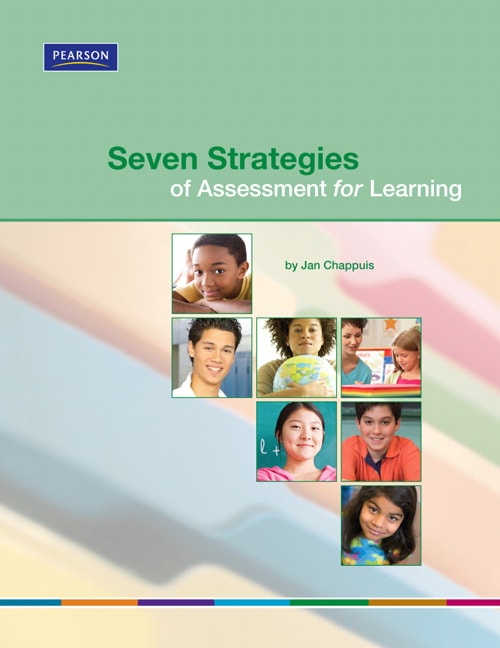
30.00$
Table of Contents
Table of Contents
CHAPTER 1: Formative Assessment and Assessment for Learning........................................1
What Is Formative Assessment?..............................................................................................................4
Summative Assessment.....................................................................................................................5
Formative or Summative?.................................................................................................................6
What Gives Formative Assessment Its Power?......................................................................................7
Formative Assessment in Teachers’ Hands......................................................................................9
Formative Assessment in Students’ Hands....................................................................................10
Seven Strategies of Assessment for Learning......................................................................................11
Where Am I Going?.........................................................................................................................11
Where Am I Now?...........................................................................................................................12
How Can I Close the Gap?...............................................................................................................13
Conclusion ............................................................................................................................................14
The Chapters Ahead.............................................................................................................................14
CHAPTER 2: Where Am I Going? Clear Targets.......................................................................15
Strategy 1: Provide students with a clear and understandable vision of the learning target............22
Converting Knowledge and Reasoning Learning Targets to
Student-friendly Language....................................................................................................................22
Defining Quality for Reasoning, Performance Skill, and Product Learning Targets....................28
When to Share the Learning Target................................................................................................41
Checking for Understanding of the Intended Learning.................................................................41
Strategy 2: Use examples and models of strong and weak work.........................................................42
Knowledge and Reasoning Learning Targets: Selected Response Items......................................42
Reasoning, Performance Skill, and Product Learning Targets:
Performance Assessment Methodology..........................................................................................43
Examples of Strategies 1 and 2 with Elementary Students.................................................................46
Inference Scenario..........................................................................................................................47
Conclusion.............................................................................................................................................51
CHAPTER 3: Where Am I Now? Effective Feedback .............................................................53
Characteristics of Effective Feedback .................................................................................................56
1. Effective feedback directs attention to the intended learning.................................................57
2. Effective feedback occurs during learning.................................................................................68
Other Feedback Variables to Consider.................................................................................................69
3. Effective feedback addresses partial understanding.................................................................70
4. Effective feedback does not do the thinking for the student....................................................72
5. Effective feedback limits correctives to what students can act on...........................................74
Suggestions for Offering Feedback.......................................................................................................75
Picture or Symbol Cues...................................................................................................................75
Assessment Dialogues.....................................................................................................................78
Peer Feedback.......................................................................................................................................83
Scaffolding a Peer Feedback Conference.......................................................................................84
Peer Response Groups....................................................................................................................87
Conclusion.............................................................................................................................................92
CHAPTER 4: Where Am I Now? Self-assessment and Goal Setting......................................93
Impact of Self-assessment on Student Achievement...........................................................................96
Three Parts: Self-assessment, Justification, and Goal Setting.............................................................99
Quick Self-assessment Ideas.................................................................................................................99
Self-assessment and Goal Setting with Selected Response and
Constructed Response Tasks...............................................................................................................103
Before: Targeting the Learning.....................................................................................................103
During: Self-assessment While Completing an Assignment, Quiz, or Test ...............................109
After: Self-assessment and Goal Setting Using the Results of a Formative Quiz or Test..........111
Self-assessment and Goal Setting with Performance Assessment Rubrics......................................117
Prerequisites.................................................................................................................................117
Ways to Format Rubric Text.........................................................................................................118
Using the Rubric Itself...................................................................................................................119
Goal Setting.........................................................................................................................................123
Helping Students Set Specific, Challenging Goals.......................................................................124
The Goal-setting Conference........................................................................................................126
Conclusion...........................................................................................................................................127
CHAPTER 5: How Can I Close the Gap? Focused Teaching and Revision.........................129
Scaffolding with Selected Response and Short Constructed Response Items.................................132
Identifying and Using Typical Misconceptions and Reasoning Errors .......................................132
Multiple-choice Items as Teaching Tools......................................................................................134
Using Graphic Organizers as Teaching Tools...............................................................................139
Scaffolding with Performance Assessment Tasks and Rubrics.........................................................141
Creating Focused Tasks.................................................................................................................141
Practicing One Criterion at a Time...............................................................................................145
Conclusion ..........................................................................................................................................146
CHAPTER 6: How Can I Close the Gap? Tracking, Reflecting On, and
Sharing Learning........................................................................................................................149
Students Keeping Track of Their Learning........................................................................................152
Recording Progress.......................................................................................................................152
Keeping Learning Journals............................................................................................................153
Collecting Samples of Work...........................................................................................................156
Students Reflecting on Their Learning...............................................................................................159
Reflecting on Growth.....................................................................................................................159
Reflecting on a Project..................................................................................................................162
Reflecting on Achievement...........................................................................................................164
Students Reflecting on Themselves as Learners..........................................................................165
Students Sharing Their Learning .......................................................................................................167
Writing to Others..........................................................................................................................167
Participating in Conferences.........................................................................................................169
Conclusion ..........................................................................................................................................174
Closing Thoughts................................................................................................................................174
Appendix A: Student-friendly Scoring Rubrics......................................................................175
Appendix B: Reproducible Forms...........................................................................................199
Bibliography ...............................................................................................................................255
***THIS IS NOT THE ACTUAL BOOK. YOU ARE BUYING the Test Bank in e-version of the following book***
Seven Strategies of Assessment for Learning PDF Manual Solutions , PDF Seven Strategies of Assessment for Learning , Fast Download Seven Strategies of Assessment for Learning , Jan Chappuis, Pearson Assessment Training Institute,Category : Higher Education

0 commentaires:
Enregistrer un commentaire